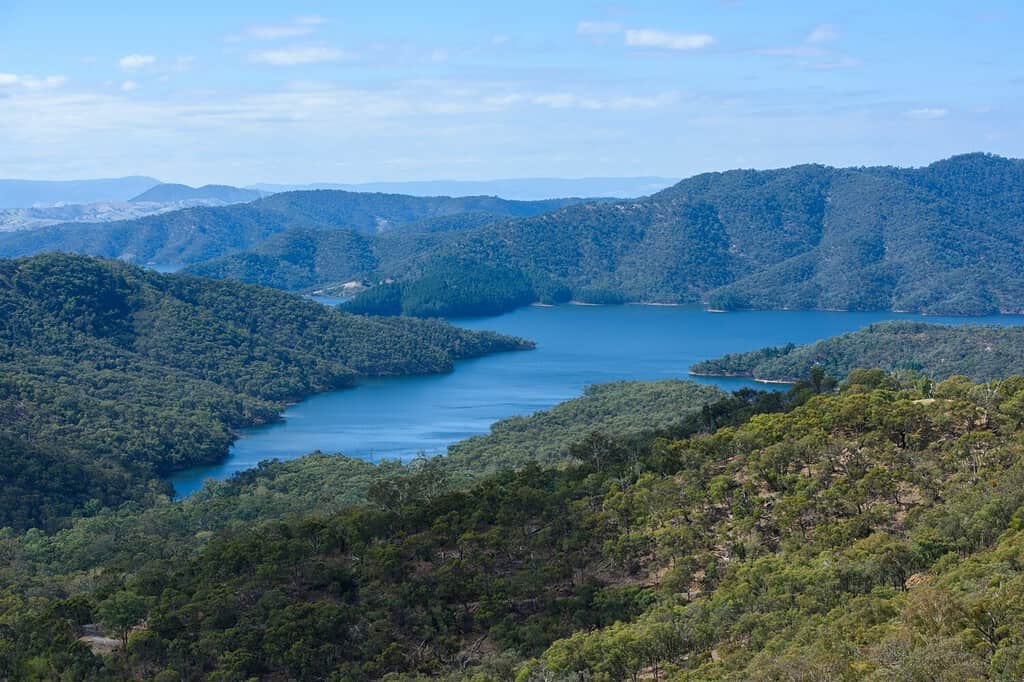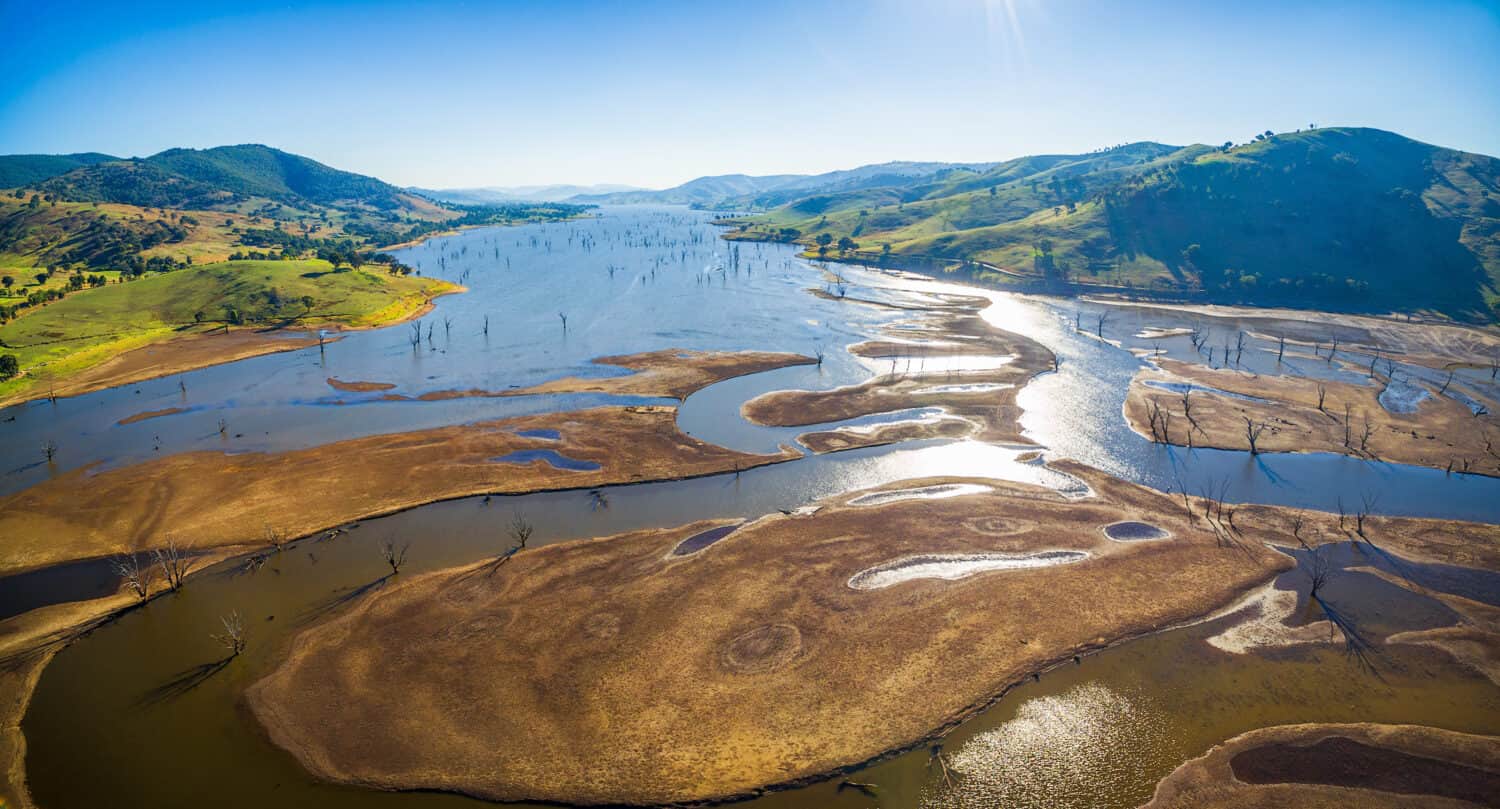Victoria, a state in Southeastern Australia, is renowned for its stunning natural landscapes and waterways. Among its notable features are the man-made lakes that dot the region. These bodies of water were created for various purposes such as irrigation, hydroelectric power generation, and water supply. In this article, we explore the four largest man-made lakes in Victoria. We delve into their origins, sizes, and the significant contributions they make to the state’s water management system.
1. Lake Eildon

Apart from its practical significance, Lake Eildon has also emerged as a popular recreational destination.
©Silv Tom/Shutterstock.com
Lake Eildon, situated on the Goulburn River, is a remarkable example of a man-made lake in Victoria, Australia. Its construction began in the 1950s as part of the ambitious Eildon Dam project. This plan aimed to regulate river flows, provide water for irrigation, and generate hydroelectric power.
Covering an expansive surface area of approximately 13,000 hectares (32,123 acres), Lake Eildon possesses a staggering water storage capacity of around 3,334 gigalitres. This immense capacity has proven crucial for water management in the region. It enables the lake to serve as a vital irrigation source and ensures a reliable water supply for agricultural.
Apart from its practical significance, Lake Eildon has also emerged as a popular recreational destination. Its tranquil waters attract boating enthusiasts, who can explore the expansive lake and enjoy various water-based activities. Fishing enthusiasts are drawn to the lake’s abundant fish population, including species such as Murray cod, golden perch, and trout. Camping facilities and picturesque surroundings make Lake Eildon an ideal spot for camping and picnicking.
The development of Lake Eildon has also provided a scenic haven for outdoor enthusiasts. Its impressive size, diverse recreational opportunities, and natural beauty make Lake Eildon popular.
2. Lake Hume

Huge Lake Hume covers an expansive surface area of approximately 20,000 hectares.
©Greg Brave/Shutterstock.com
Lake Hume, nestled on the banks of the mighty Murray River, is a testament to engineering prowess. It also exemplifies the harmonious coexistence of practicality and natural beauty. Its origins trace back to the early 1910s when construction began on the Hume Dam. This project sought to regulate river flows to support irrigation needs.
Covering an expansive surface area of 20,000 hectares (49,900 acres), Lake Hume is one of the largest lakes in Australia. Its vast water storage capacity of around 3,005 gigalitres ensures a reliable water supply for agriculture and irrigation.
Beyond its practical significance, Lake Hume offers a haven for water-based recreational activities and scenic wonder. The surroundings attract boating enthusiasts eager to explore its waters. Fishing enthusiasts are rewarded with an abundance of fish species such as Murray cod, golden perch, and freshwater catfish. The lake’s tranquil ambiance and stunning vistas make it a popular destination for camping and picnicking.
Lake Hume’s multifaceted role as a water source, recreational hotspot, and scenic masterpiece showcases the successful integration of human ingenuity and the natural environment. Its grandeur, diverse recreation, and pretty views make Lake Hume an iconic destination. It captivates both visitors and locals, leaving them with lasting memories.
3. Lake Dartmouth

Lake Dartmouth is a huge man-made lake in the Alpine region of Victoria, Australia.
©Greg Brave/Shutterstock.com
Nestled in the Alpine region of Victoria, Lake Dartmouth is a great feat of engineering. The lake’s story began in the 1970s with the commencement of the Dartmouth Dam project. This remarkable endeavor aimed to regulate river flows, generate hydroelectric power, and ensure a reliable water supply for irrigation purposes.
Encompassing a surface area of 6,300 hectares (15,568 acres), Lake Dartmouth has a water storage capacity of around 3,900 gigalitres. This vast expanse is not only crucial for fulfilling irrigation needs but it also serves as a haven for nature-lovers.
The picturesque surroundings of Lake Dartmouth make it a sought-after fishing spot. It holds an abundance of fish species such as trout, Murray cod, and golden perch. Anglers can cast their lines and experience the thrill of reeling in a prized catch amidst stunning scenery.
Boating enthusiasts are also drawn to Lake Dartmouth, enticed by its calm waters and tranquil corners. Whether it’s a leisurely cruise or an adrenaline-pumping water-skiing adventure, the lake offers something for everyone.
4. Lake Glenmaggie
Lake Glenmaggie, in the region of Gippsland, began in the early 1920s with the inception of the Glenmaggie Weir project. This visionary endeavor aimed at regulating river flows and ensuring a dependable water supply for the fertile lands of Gippsland.
Spanning a surface area of 2,500 hectares (6,177 acres), Lake Glenmaggie boasts a substantial water storage capacity of 90 gigalitres. This immense reservoir safeguards water supplies for irrigation purposes. It also provides a haven for recreational activities, captivating the hearts of both locals and tourists.
The tranquil waters of Lake Glenmaggie offer a perfect setting for leisurely cruises and exhilarating water-skiing adventures. The expansive lake provides ample space for exploration and unforgettable moments.
Camping enthusiasts are drawn to Lake Glenmaggie’s inviting shores, where they can pitch their tents and be among nature. The idyllic surroundings provide the ideal backdrop for picnics, barbecues, and evenings spent stargazing. The area fosters a sense of connection with the great outdoors.
Last but not least, Lake Glenmaggie’s reputation as a fishing paradise adds to its allure. The lake is teeming with a variety of fish species, including trout, redfin, and Australian bass.
In Conclusion
The largest man-made lakes in Victoria, Australia play vital roles in the state’s water management system. These lakes serve purposes ranging from irrigation and hydroelectric power generation to water supply and recreational activities. With their vast surface areas and substantial water storage capacities, these lakes contribute to sustainable development. They continue to provide stunning natural landscapes for visitors.
The photo featured at the top of this post is © BMRImage/Shutterstock.com
Thank you for reading! Have some feedback for us? Contact the AZ Animals editorial team.







